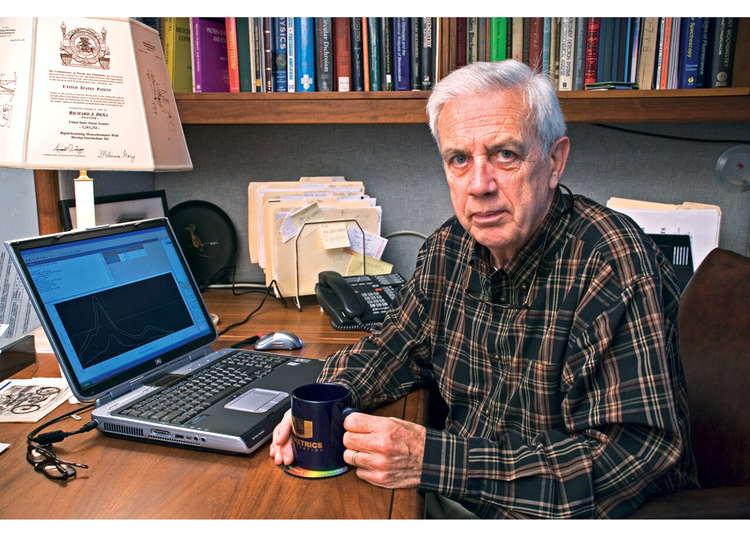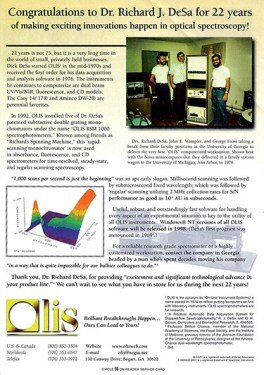Uv/vis Things To Know Before You Buy

Branch of spectroscopy Table-top spectrophotometer Beckman IR-1 Spectrophotometer, ca. 1941 Beckman Design DB Spectrophotometer (a double beam design), 1960 Hand-held spectrophotometer utilized in graphic market Spectrophotometry is a branch of electromagnetic spectroscopy concerned with the quantitative measurement of the reflection or transmission properties of a material as a function of wavelength.
Although spectrophotometry is most commonly used to ultraviolet, noticeable, and infrared radiation, modern-day spectrophotometers can interrogate wide swaths of the electro-magnetic spectrum, including x-ray, ultraviolet, visible, infrared, and/or microwave wavelengths. Spectrophotometry is a tool that hinges on the quantitative analysis of particles depending on just how much light is soaked up by colored substances.
Circularly Polarized Luminescence Things To Know Before You Buy
A spectrophotometer is frequently used for the measurement of transmittance or reflectance of solutions, transparent or nontransparent solids, such as polished glass, or gases. Many biochemicals are colored, as in, they absorb visible light and therefore can be measured by colorimetric procedures, even colorless biochemicals can typically be converted to colored compounds appropriate for chromogenic color-forming responses to yield substances ideal for colorimetric analysis.: 65 However, they can likewise be created to measure the diffusivity on any of the listed light varieties that typically cover around 2002500 nm using different controls and calibrations.
An example of an experiment in which spectrophotometry is utilized is the decision of the equilibrium constant of a service. A certain chain reaction within a service might occur in a forward and reverse direction, where reactants form products and items break down into reactants. At some point, this chemical reaction will reach a point of balance called an equilibrium point.
Some Known Details About Circularly Polarized Luminescence
The amount of light that goes through the solution is indicative of the concentration of particular chemicals that do not permit light to travel through. The absorption of light is because of the interaction of light with the electronic and vibrational modes of molecules. Each type of particle has an individual set of energy levels associated with the makeup of its chemical bonds and nuclei and therefore will soak up light of particular wavelengths, or energies, leading to unique spectral residential or commercial properties.
The usage of spectrophotometers covers various scientific fields, such as physics, products science, chemistry, biochemistry. spectrophotometers, chemical engineering, and molecular biology. They are widely utilized in lots of industries including semiconductors, laser and optical production, printing and forensic examination, along with in laboratories for the study of chemical compounds. Spectrophotometry is frequently utilized in measurements of enzyme activities, determinations of protein concentrations, determinations of enzymatic kinetic constants, and measurements of ligand binding reactions.: 65 Ultimately, a spectrophotometer is able to determine, depending on the control or calibration, what substances are present in a target and precisely just how much through estimations of observed wavelengths.
This would come as a service to the previously produced spectrophotometers which were not able to soak up the ultraviolet properly.
Excitement About Uv/vis
It would be discovered that this did not provide satisfying outcomes, therefore in Design B, there was a shift from a glass to a quartz prism which permitted much better absorbance outcomes - spectrophotometers (https://www.abnewswire.com/companyname/olisclarity.com_129679.html#detail-tab). From there, Model C was born with a modification to the wavelength resolution which wound up having 3 systems of it produced
It was produced from 1941 to 1976 where the cost for it in 1941 was US$723 (far-UV devices were an option at extra expense). In the words of Nobel chemistry laureate Bruce Merrifield, it was "probably the most essential instrument ever developed towards the advancement of bioscience." Once it ended up being discontinued in 1976, Hewlett-Packard created the first commercially readily available diode-array spectrophotometer in 1979 known as the HP 8450A. It irradiates the sample with polychromatic light which the sample soaks up depending upon its residential or commercial properties. It is transmitted back by grating the photodiode selection which detects the wavelength area of the spectrum. Ever since, the development and implementation of spectrophotometry gadgets has increased tremendously and has ended up being one of the most ingenious instruments of our time.

The 2-Minute Rule for Spectrophotometers
The grating can either be movable or repaired.
In such systems, the grating is fixed and the strength of each wavelength of light is measured by a different detector in the range. Furthermore, most modern-day mid-infrared spectrophotometers utilize a Fourier change method to get the spectral information - https://dzone.com/users/5082179/olisclarity1.html. This method is called Fourier transform infrared spectroscopy. When making transmission measurements, the spectrophotometer quantitatively compares the fraction of light that travels through a referral solution and a test option, then electronically compares the strengths of the two signals and computes the portion of transmission of the sample compared to the referral standard.

Comments on “The smart Trick of Spectrophotometers That Nobody is Discussing”